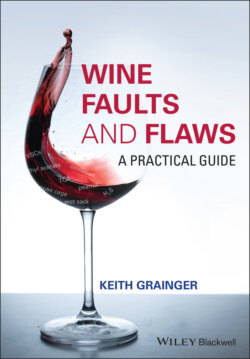Читать книгу Wine Faults and Flaws - Keith Grainger - Страница 16
1.4 The Possible Impact of Some Fault Compounds Upon Human Health
ОглавлениеMost of the faults discussed in this book, however unpleasant they may be from an organoleptic point of view, are not generally harmful to human health, at least at the concentrations in which they may be found in wine. Wine has a low pH and pathogens harmful to humans will not generally grow in the product (although we should remember that every year somewhere in the world people die as a result of consuming ‘fake’ wine). There are, however, some compounds of microbiological origin that may be found in wine that have been shown to be potentially harmful to humans. The most important of these are biogenic amines, ochratoxin A and ethyl carbamate. Ethyl carbamate is classified as ‘a probable human carcinogen’ (Group 2A) by the International Agency for Research on Cancer (IARC) [6], and several countries have set limits for its concentration in wine. Biogenic amines are toxic at high concentrations, and some people have an intolerance at the levels very often found in wine. Ochratoxin A is a known carcinogen in some animals and a suspected human carcinogen by IARC (Group 2B) [6]; accordingly limits to its concentration in wine have been set by the European Commission (EC) for member states of the European Union (EU) at 2 μg/l [7]. In addition, some chemical compounds which may be found in wine can be harmful, particularly phthalates that can be hormone disruptors in humans. Their presence in wine is always due to contamination from an external source, such as the epoxy resin lining of concrete fermentation or storage vats. In a research paper published in 2014, Pascal Chatonnet et al. revealed that significant quantities of dibutyl phthalate (DBP) had been found in 59% of the (French) wines analysed [8]. Although, with the possible exception of biogenic amines that can have a ‘blood‐like’ odour and taste, the above compounds do not influence aroma or taste, their presence in wine other than at very low levels should be regarded as a fault; more of this will be discussed in Chapter 14.
Of course ethanol, the alcohol of all fermented drinks, is a known carcinogen and is classified as ‘a human carcinogen’ (Group 1) by the IARC [6]. It is toxic if consumed in excess, and there are reported cases of death due to alcohol poisoning and other issues related to single acts of excessive consumption. Long‐term regular consumption of ethanol, other than at low levels, is also a causal factor in several carcinomas, liver diseases, and other health problems such as obesity, as wine lovers and imbibers of other alcoholic beverages are regularly made aware. Acetaldehyde is considered a fault in wine only if present in excessive amounts, which generally means having a negative impact upon aroma, but when associated with alcohol consumption is also classified as ‘a human carcinogen’ (Group 1) by the IARC [6].
